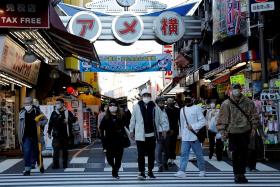Gaza buries dead after bloodiest clash with Israel since 2014
Death toll rises to 60, with more than 2,200 Palestinians injured in bloodiest clashes since 2014
GAZA-ISRAEL BORDER: Thousands of Gaza residents turned out yesterday for the funerals of Palestinians killed by Israeli troops a day earlier, while on the Gaza-Israel border, Israeli forces prepared to face the expected final day of a Palestinian protest campaign.
Monday's violence on the border, which took place as the US opened its new embassy in Jerusalem, was the bloodiest for Palestinians since the 2014 Gaza conflict.
The death toll rose to 60 overnight after an eight-month-old baby died from tear gas that her family said she inhaled at a protest camp on Monday. More than 2,200 Palestinians were also injured by gunfire or tear gas, Palestinian medics said.
Palestinian leaders have called Monday's events a massacre, and the Israeli tactic of using live fire against the protesters has drawn worldwide concern and condemnation.
The United Nations Security Council was due to meet to discuss the situation.
Israel has said it is acting in self-defence to defend its borders and communities.
Its main ally the United States has backed that stance, with both saying that Hamas, the Islamist group that rules the coastal enclave, instigated the violence.
Yesterday morning, mourners marched through Gaza, waving Palestinian flags and calling for revenge.
There were fears of further bloodshed as a six-week protest campaign was due to reach its climax. May 15 is traditionally the day Palestinians mark the "Nakba", or Catastrophe, when hundreds of thousands fled or were driven from their homes in violence culminating in war between the newly created Jewish state and its Arab neighbours in 1948.
The protests began on March 30 and have revived calls for refugees to have the right of return to former lands, which now lie inside Israel.
Israel rejects that right , fearing that it would deprive the state of its Jewish majority.
Palestinian medical officials say 105 Gazans have now been killed since the start of the protests and nearly 11,000 people wounded, about 3,500 of them hit by live fire.
Israeli officials dispute those numbers. No Israeli casualties have been reported.
More than 2 million people are crammed into the narrow Gaza Strip, more than two thirds of them refugees. Citing security concerns, Israel and Egypt maintain tight restrictions on the enclave, deepening economic hardship and raising humanitarian concerns.
On the Israeli side of the border, Israeli sharpshooters watch the fence for breaches by protesters. Tanks were also deployed.
A senior Israeli commander said that of the 60 Gazans killed on Monday, 14 were carrying out attacks and 14 others were militants.
He also said Palestinians protesters were using hundreds of pipe bombs, grenades and fire-bombs. Militants had opened fire on Israeli troops and tried to set off bombs by the fence.
Many casualties were caused by Palestinians carrying out devices that went off prematurely, he said.
In Geneva, the UN human rights office condemned what it called the "appalling deadly violence" by Israeli forces.
UN human rights spokesman Rupert Colville said Israel had a right to defend its borders according to international law, but lethal force must only be used a last resort, and was not justified by Palestinians approaching the Gaza fence.
Monday's protests were fuelled by the opening of the new US Embassy in Jerusalem, after it was moved from Tel Aviv. The move fulfilled a pledge by US President Donald Trump, who in December recognised the contested city as the Israeli capital.
Palestinians see East Jerusalem as the capital of a state they hope to establish in the occupied West Bank and the Gaza Strip. Israel regards all of Jerusalem as its "eternal and indivisible capital". - REUTERS
Get The New Paper on your phone with the free TNP app. Download from the Apple App Store or Google Play Store now



